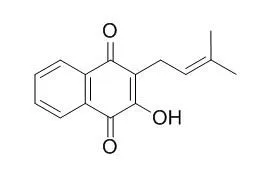| In vitro: |
| Lett Appl Microbiol. 2014 Jul;59(1):108-14. | | Cytotoxicity of lapachol metabolites produced by probiotics.[Pubmed: 24635204] | Probiotics are currently added to a variety of functional foods to provide health benefits to the host and are commonly used by patients with gastrointestinal complaints or diseases. The therapeutic effects of Lapachol continue to inspire studies to obtain derivatives with improved bioactivity and lower unwanted effects. Therefore, the general goal of this study was to show that probiotics are able to convert Lapachol and are important to assess the effects of bacterial metabolism on drug performance and toxicity.
METHODS AND RESULTS:
The microbial transformations of Lapachol were carried out by Bifidobacterium sp. and Lactobacillus acidophilus and different metabolites were produced in mixed and isolated cultures. The cytotoxic activities against breast cancer and normal fibroblast cell lines of the isolated metabolites (4α-hydroxy-2,2-dimethyl-5-oxo-2,3,4,4α,5,9β-hexahydroindeno[1,2-β]pyran-9β-carboxilic acid, a new metabolite produced by mixed culture and dehydro-α-lapachone produced by isolated cultures) were assessed and compared with those of Lapachol. The new metabolite displayed a lower activity against a breast cancer cell line (IC50 = 532.7 μmol l(-1) ) than Lapachol (IC50 = 72.3 μmol l(-1) ), while dehydro-α-lapachone (IC50 = 10.4 μmol l(-1) ) displayed a higher activity than Lapachol. The present study is the first to demonstrate that probiotics are capable of converting Lapachol into the most effective cytotoxic compound against a breast cancer cell line.
CONCLUSIONS:
Probiotics have been used in dairy products to promote human health and have the ability to metabolize drugs and other xenobiotics. Naphthoquinones, such as Lapachol, are considered privileged scaffolds due to their high propensity to interact with biological targets. The present study is the first to demonstrate that probiotics are capable of converting Lapachol into the most effective cytotoxic compound against a breast cancer cell line. The developed approach highlights the importance of probiotics to assess the effects of bacterial metabolism on drug performance and toxicity. | | Bioorg Med Chem. 2008 Jan 15;16(2):668-74. | | Trypanosoma cruzi: activities of lapachol and alpha- and beta-lapachone derivatives against epimastigote and trypomastigote forms.[Pubmed: 18029184 ] |
METHODS AND RESULTS:
Derivatives of natural quinones with biological activities, such as Lapachol, alpha- and beta-lapachones, have been synthesized and their trypanocidal activity evaluated in vitro in Trypanosoma cruzi cells. All tested compounds inhibited epimastigote growth and trypomastigote viability. Several compounds showed similar or higher activity as compared with current trypanocidal drugs, nifurtimox and benznidazole. The results presented here show that the anti-T. cruzi activity of the alpha-lapachone derivatives can be increased by the replacement of the benzene ring by a pyridine moiety.
CONCLUSIONS:
Free radical production and consequently oxidative stress through redox cycling or production of electrophilic metabolites are the potential biological mechanism of action for these synthetic quinones. | | Bioorg Med Chem Lett. 2004 Mar 8;14(5):1145-9. | | Antimalarial activity of phenazines from lapachol, beta-lapachone and its derivatives against Plasmodium falciparum in vitro and Plasmodium berghei in vivo.[Pubmed: 14980653] |
METHODS AND RESULTS:
The antimalarial activity of benzo[a]phenazines synthesized from 1,2-naphthoquinone, Lapachol, beta-lapachone and several derivatives have been tested against Plasmodium falciparum in vitro using isolates of parasites with various susceptibilities to chloroquine and/or mefloquine. Parasite growth in the presence of the test drugs was measured by incorporation of [(3)H]-hipoxanthine in comparison to controls with no drugs, always testing in parallel chloroquine, a standard antimalarial. Among seven benzophenazines tested, four had significant in vitro activities; important, the parasites resistant to chloroquine were more susceptible to the active phenazines in vitro. The doses of phenazines causing 50% inhibition of parasite growth varied from 1.67 to 9.44 microM. The two most active ones were also tested in vivo against Plasmodium berghei in mice, in parallel with Lapachol and beta-lapachone. The 3-sulfonic acid-beta-lapachone-derived phenazine was the most active causing up to 98% inhibition of parasitaemia in long term treatment (7 doses) subcutaneously, whereas the phenazine from 3-bromo-beta-lapachone was inactive.
CONCLUSIONS:
Thus, these simple phenazines, containing polar (-Br,-I) and ionizable (-SO(3)H, -OH) groups, easily synthesized from cheap, natural or synthetic precursors (Lapachol and beta-lapachone), at rather low cost, provide prototypes for development of new antimalarials aiming the chloroquine resistant parasites. |
|






 Cell. 2018 Jan 11;172(1-2):249-261.e12. doi: 10.1016/j.cell.2017.12.019.IF=36.216(2019)
Cell. 2018 Jan 11;172(1-2):249-261.e12. doi: 10.1016/j.cell.2017.12.019.IF=36.216(2019) Cell Metab. 2020 Mar 3;31(3):534-548.e5. doi: 10.1016/j.cmet.2020.01.002.IF=22.415(2019)
Cell Metab. 2020 Mar 3;31(3):534-548.e5. doi: 10.1016/j.cmet.2020.01.002.IF=22.415(2019) Mol Cell. 2017 Nov 16;68(4):673-685.e6. doi: 10.1016/j.molcel.2017.10.022.IF=14.548(2019)
Mol Cell. 2017 Nov 16;68(4):673-685.e6. doi: 10.1016/j.molcel.2017.10.022.IF=14.548(2019)